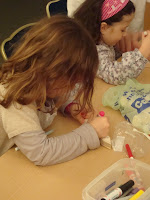
Lighting the candles at Hanukah :
We place the candles in the hanukkiyah (8 branch menorah) from right to left. To light the menorah we us the highest candle on the menorah which is called the shamash, also known as the servant/helper candle. Once the shamash is lit two blessings are said. The first blessing is said over the hannukah candles :
We place the candles in the hanukkiyah (8 branch menorah) from right to left. To light the menorah we us the highest candle on the menorah which is called the shamash, also known as the servant/helper candle. Once the shamash is lit two blessings are said. The first blessing is said over the hannukah candles :
Baruch atah Adonai, eloheinu melech ha'olam, asher kidushanu b'mitzvotav vitzinvanu l'hadlik ner shel hanukkah.
The second blessings gives thanks for all the miracles :
Baruch atah Adonai, eloheinu melech ha'olam, she-asah nissim lavoteinu ba-yamim hahem bazman hazeh.
On the first night, and only on the first night, a third prayer is added to giv thanks for being able to celebrate the holiday. This pray is also said at the beginning of most holidays and at a new and happy event :
Baruch ata Adonai, eloheinu melech ha-olam shehechiyanu vekiymanu vehigiany lazman hazeh.
Then using the shamash we light the first candle, and one by one every night starting with the newest candle and moving toward the right.
These small and pretty candles are a reminder taht even the small, when they stand together can light the darkness.
 What is a dreidel :
What is a dreidel :A dreidel is a spinnng top. The word dreidel means "turn".
The dreidel has four sides, on each side there is a hebrew letter : Nun, gimel, hey and shin. These letters stand for the words, Nes Gadol Haya Sham which means A Miracle Happened There. There indicates Israel.
How did it all start :
Dreidel game began when the King Antiochus forbade the Jews to study Torah,the Jewish Bible. Grops of children who had secretly meorized the entire Torah studied together until they heard teh footsetps of the soldiers approaching. Then they quickly pulled out spinning tops and pretended to be playing games.
Rules to play the game:
Each child gets the same number of tokens, which are often nuts, candy, or coins. Each child puts two or three tokens into the middle. Then he/she takes a turn spinning the dreidel.
Usually you use candy or nuts to play this game. In case you don't have those items to play with, we've added points here for you to use.
 - Nes ... N or nun stands for nisht or nothing. If the dreidel lands on nun, you do nothing.
- Nes ... N or nun stands for nisht or nothing. If the dreidel lands on nun, you do nothing.No Points.
 - Gadol ... G or gimel stands for ganz or all. Take everything in the middle.
- Gadol ... G or gimel stands for ganz or all. Take everything in the middle.Get all the tokens in the middle.
 - Haya ... H or hay stands for halb or half. Take half of what is in the middle plus one if there is an odd number of objects.
- Haya ... H or hay stands for halb or half. Take half of what is in the middle plus one if there is an odd number of objects. 












